The Maple Leafs earned their split, and we have ourselves a series.
Auston Matthews and his line were fantastic. The Leafs got a penalty kill and a power-play goal when they needed it. Ilya Samsonov stood his ground, and the fourth line was excellent. We head back to Toronto with a best-of-five series on our hands and the Leafs possessing home-ice advantage.
Your game in 10:
1. This game got off to another physical start. In Game 1, Sheldon Keefe started the Auston Matthews line, and the contest was feisty before the puck even dropped. Tonight, Keefe started the John Tavares line with the Jake McCabe pairing, and McAvoy promptly rocked Knies. There were big hits both ways, as Joel Edmundson took a big run at DeBrusk, Simon Benoit ran Marchand, Pastrnak planted Tavares, and Tavares got him back a few seconds later.
There weren’t many scoring chances, but the Leafs could feel pretty good about things as the game started to settle in. They had a slight edge in play, and Boston wasn’t creating much. Then, off a nothing play that Ilya Samsonov covered with ease, Lauko coasted by the net, and Jake McCabe gave him a little cross-check from behind.
Lauko went down very, very easily. He instantly looked at the ref—clearly selling it—and the refs gave it to them. It took Boston all of 25 seconds to score on the power play. It’s way too easy for Boston’s power play right now.
The Bruins fanned on a puck, and instead of David Kampf simply clearing it — or at least attempting to — he tried to leave the puck for his defenseman to handle it instead. This is the NHL playoffs. With a look to clear, he has to be strong on the puck and clear it. Kampf didn’t, and the Leafs were out of position as a result. The Bruins cashed in on a simple down-low 2v1 backdoor play that Samsonov had no chance on. This was a gift.
2. For the sixth straight game, the Leafs conceded the first goal against the Bruins, the crowd started getting into the game for really the first time since the anthems, and it was fair to wonder how exactly the Leafs would respond. Well, 14 seconds later, they tied the game.
The goal is an example of what the Leafs need to do more of. They just dumped the puck and forechecked. Tyler Bertuzzi made a good soft flip to the corner, which gave Max Domi extra time to get to the corner and apply pressure. The puck went right up the wall, where Auston Matthews was supporting. The puck went to the slot, Bertuzzi won the battle, and the puck landed for Matthews, who ripped a shot off the crossbar. Domi won another battle in front to get to the puck and jam home the rebound, tying the game immediately.
That’s a great response from the top line, and there’s a roadmap to success there: dump the puck in, forecheck, get pucks to the slot, and win battles. It also quieted the crowd and seemed to settle the Leafs down.
3. After the goal, the Leafs started stringing together some good shifts. Ryan Reaves produced an excellent shift, pasting two Bruins, helping to hem the puck in Boston’s end, and drawing a penalty. Suddenly, the Leafs went to a power play with a chance to take the lead, and Matthews got a 10-bell chance in front that he did not bury. By comparison, it is the type of chance that the Bruins are constantly cashing in against the Leafs so far, and it prevented Toronto from taking their first lead in over five games against the Bruins.
The Leafs still strung together good shifts — namely, from their fourth line and first line — and looked to be taking a tie into the intermission until a calamity of errors unfolded. First, the puck trickled down to Ilya Samsonov, who had defensemen on either side of him with one Bruin pressuring. He fanned on the first pass to Timothy Liljegren but got a second one off to him rather cleanly. Liljegren made a simple bounce pass to Edmundson behind the net, and Edmundson missed the puck, leading to a turnover. He’s a 30-year-old veteran who has been to two Cups; he simply cannot miss that puck.
After the Bruins got a shot and an offensive-zone faceoff out of nothing, their top line came out against the John Tavares unit and the Simon Benoit – Jake McCabe pairing. From there, it was a complete mess for the Leafs. Benoit challenged Pastrnak up the wall, which I was completely fine with. He should stick to him like glue. The problem is that he then started watching and chasing the puck instead of following his man, which had a domino effect of others chasing the puck and ending up out of position.
This whole sequence is really on Benoit chasing the puck instead of simply staying with one of the best goal-scorers in the league and then Mitch Marner not reading it on the backside and supporting his defenseman. What was a good period for the Leafs ended with them down 2-1 after shooting themselves in the foot yet again.
4. As is usually the case, the goal to end the period went to the Bruins’ legs, and they challenged to extend the lead early in the middle frame. Part of it, too, was the Leafs pushing up ice to try to tie the game. The Bruins created an early 2v1 when Benoit pinched and Connor Dewar tried to keep the puck in instead of simply backing off. Geekie poked it by him and went down the ice on an odd-man rush. To Dewar’s credit, he hustled back to help even out the rush, and Jake McCabe made a nice diving play.
The Bruins also went on a mini 2v1, during which Ilya Samsonov made one of his best saves of the night, going post to post and standing tall as the puck was batted out of the air and the rebound was available. That chance came with the Tavares line on the ice—a continuation of the first period, during which they were simply the worst line on the ice for either team.
The Leafs are using the Tavares-Marner line in a tough role, but they were bordering on unplayable for large stretches of this game. Marner, in particular, refuses to play north-south, playoff-style hockey, and he actively bailed on a puck along the wall as McAvoy closed on it. Even with Nylander in the lineup, the Leafs need Marner to be a star, but without Nylander, it is extra imperative that Marner is effective. Instead, the team is forced to compensate for how little he is doing.
The expected goal share of that line through two periods—which I generally hate looking at for a single game, let alone mid-game, as it’s such a small sample that it can lead to some wacky results—was 2.9%. That number might have been generous. As the period continued, even Keefe couldn’t continue turning to it, so he started mixing Marner in with Matthews and had Jarnkrok take a shift with Tavares and Knies. Both shifts went much better.
There is so much talk about the Leafs’ PK and defense; despite both struggling, despite injuries to Nylander (and McMann) and despite Marner’s non-existence (bordering on a liability), the Leafs were right in this game on the road.
5. The Leafs stuck with it. They got a power play on a Bruins too-many-men infraction and created some really good looks — namely, Matthews in the slot (one you’d like to see him bury) and a Jarnkrok one-timer in the slot off a fortunate bounce that the NHL reviewed to see if it crossed the line. It looked like Ullmark pulled it around the post, but there wasn’t enough proof to actually call it a goal.
The Leafs persisted, and on a good offensive-zone shift, Tavares was taken down in front while the puck was nowhere near him. In a rare occurrence, it was actually called. That created a huge moment in the game; the Leafs had hung around in a one-goal game, and it was now late in the second period with an opportunity to tie it up.
Four seconds in, it looked like they did. They won the faceoff, Marner cut across and shot it, the puck popped in the air, and Bertuzzi batted it down into the net. The call on the ice was a goal, but they reviewed it and called it a high stick, which I thought was the right call. Truthfully, Bertuzzi could have waited an extra second; he had the time, and Matthews was also right there.
It could have been a momentum zapper, but the Leafs stuck with it again and tied the game. The goal itself was a bit of a broken play. The Bruins aggressively pressured the point, and the Leafs needed to look for little bump plays to alleviate the pressure. Matthews did that, but the pass was a little off the mark. Jarnkrok did really well to engage DeBrusk, and the puck slid by both players over to Tavares. The Leafs captain had time in the slot to turn and shoot, and he scored short side. Tie game going into the third.
6. The third period started with the teams trading chances. The Leafs forced an icing right away, and the Matthews line had a chance in tight as Domi found Matthews at the back post, where he took a spinning shot on net. At the other end, Samsonov made a diving pad save on Marchand following a rebound right before Marchand missed the puck on a backdoor play with a wide-open net.
Shortly afterward, the game went to 4v4 as Ryan Reaves took a penalty for holding a stick that caused a too-many-men penalty by the Bruins. There wasn’t a ton going on in the 4v4, but the Bruins had Maroon serve the penalty, and when he came out of the box, Keefe made a smart adjustment to get the Matthews line on the ice. They created another scoring chance.
The biggest save, though, came on Nick Robertson. When Jarnkrok shot a puck from the point, it deflected off Holmberg’s shin pad and right to Robertson, who–to his credit–elevated the puck and shot it hard. Ullmark came up with a huge save; otherwise, the Leafs would have held the lead about halfway through the third period.
7. Keefe really started looking for opportunities to bump Mitch Marner up to the top line, in part probably to push for a goal but also because the second line was just so bad. You could feel the coach trying to steal shifts and work the ice time at points in between Matthews shifts; the lack of Nylander and McMann was noteworthy.
On Boston’s end, Andrew Peeke left the game, leaving them with five defensemen. Toronto’s third and fourth lines did well to simply skate and hustle. This put miles on the likes of McAvoy and Carlo; the Leafs’ energy lines forechecked hard, giving them no easy shifts. Those are the little games within a game—energy players making the Bruins defenders work and gassing them in their minutes.
It finally paid off. The goal itself was pretty innocent at the onset—Max Domi flipped a puck to the far blue line—but McAvoy read it and played it poorly. Auston Matthews took advantage. He came in flying with speed, jumped, caught the puck, and, in one motion, went around McAvoy with the puck for a clear breakaway. The best goal scorer in the world did what he does: faking backhand, getting Ullmark down, and pulling it forehand into a wide-open net.
Matthews was a monster in this game — this was his third point — as he played a massive 23:24. He was credited with eight shots on net and six hits, too. His line dominated shift after shift. It was the first game against Boston in which a Leaf was the best player on the ice, and it was Matthews by a landslide. The Leafs needed a superstar effort, and they got it. Domi added two points, and Bertuzzi also grabbed an assist. This trio is clearly clicking.
It was a huge moment for not just Matthews but for the Leafs—Toronto’s first lead in any game against the Bruins this season.
8. The Bruins tried pushing now that they were finally down in a game, and they weren’t creating much of anything. And then an example of the penalty nonsense reared its ugly head. On an innocent shot right into Samsonov’s chest, Coyle inadvertently poked at Samsonov, and when he did, he clipped him in the face. Ilya Lyubushkin took exception — generally speaking, I get it. If the game was in the first period, have at it. But up a goal in the third period on the road, he can’t lose his cool, and Lyubushkin did.
They were calling Coyle for a penalty, too, and as the players converged, Tyler Bertuzzi gave Marchand a little stick in the back of the knee. Marchand went down like he got shot (we have yet to confirm if he will ever be able to walk again). That’s what the Bruins do. Bertuzzi headed to the box, and the Leafs were facing their most important penalty kill of the season.
They were great. The Bruins got nothing out of it. The Leafs pressured them, got some good clears, and were tight in the neutral zone–especially on one play where DeBrusk tried a bank pass down the ice from his own end (which the Bruins love), and the Leafs snuffed it out. The best chance came right after the penalty expired as the puck leaked out to Marchand in the high slot all alone, where he elected to make a passing play in front. It was a curious decision, but the Leafs will take it.
The other part of the penalty kill effort was Samsonov’s excellence. On the one real Pastrnak look, he was well out of his crease and closed down the angle on him, swallowing up the puck. A huge kill.
9. With a one-goal lead late in the game, the Leafs ran Jarnkrok-Kampf-Dewar, who generated a great shift pushing the puck deep and forechecking. The Leafs have a lot of workers on this team, and they have to invest in it. This is how the Bruins have lost the past two years to Florida and Carolina—both teams forechecked them to the death. The Leafs have the speed and workers to do it.
Following an icing, the Leafs went with Bertuzzi-Matthews-Marner, who were doing a good job with McCabe and Rielly. When the puck went deep on Morgan Rielly, he tried to make a play instead of ripping it off the glass and out. It almost cost the Leafs dearly; there was a mad scramble in front with diving bodies all over the place, but Samsonov held his ground, and somehow the puck stayed out.
The Leafs closed with a line of Tavares, Kampf, and Marner. It’s not something we have seen very often, but Taraves and Marner did well on the boards, and then David Kampf won a huge battle to get the puck deep, essentially icing the game. One PK blunder aside, Kampf was excellent in this game; his line was fantastic, and Connor Dewar was also a really dependable checker.
Joel Edmundson was also on for the defensive-zone faceoff at the end of the game, and as the Bruins came back down with a second left, I enjoyed him hacking down McAvoy, knowing the clock was about to expire. Much like Kampf, after Edmundson’s blunder in the first, he was excellent. He played 22:38, second most among Leafs defensemen, and he was steady. Rather quietly, he started snapping some excellent breakout passes down the ice, and he clearly knows how to play in the playoffs. He’s barely played since coming to Toronto, so the hope is he only improves with each passing game.
10. This is the type of game that will leave the Bruins asking questions of themselves. Ullmark was solid and made a huge save to keep the Bruins tied in the third, but the Leafs won, so the goaltending decision will be questioned. Auston Matthews‘ line scored two goals against Hampus Lindholm; will that change their strategy now? The Leafs’ fourth line played so well that the Bruins changed the matchups against them (putting their third line against the Leafs’ fourth).
Nylander’s return (not to mention McMann!) would really put the Bruins in a blender regarding matchups. There is so much talk about the Leafs’ defense—and it isn’t pretty—but the Bruins are going to have a lot of trouble matching up against this Leafs forward group, and Toronto is missing two really important players right now.
The Leafs have to get pucks in deep, forecheck, funnel pucks to the net down low, and realistically, their defense has to simplify and not be afraid to put pucks off the glass—the game-winner in this one was just a flip pass to the far blue line. They have controlled play in both games against Boston thus far, even without Nylander. As we said before the series, the Bruins have been generally outplayed this season and ride their goaltending. If the Leafs break through on their netminders, Boston doesn’t have a ton of firepower to overcome it.
The Bruins will surely respond, and Swayman will almost certainly be in the net for Game 3—the Leafs are 0-4 against him—but we have a battle on our hands now. Buckle up.
Game Flow: 5v5 Shot Attempts
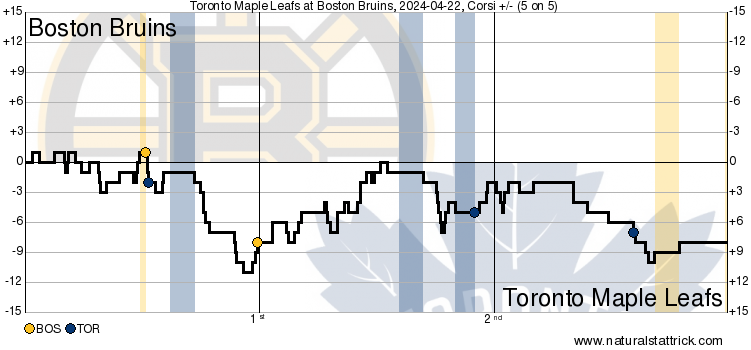
Heat Map: 5v5 Shot Attempts









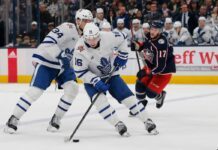





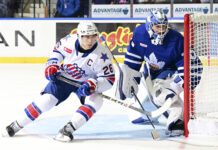









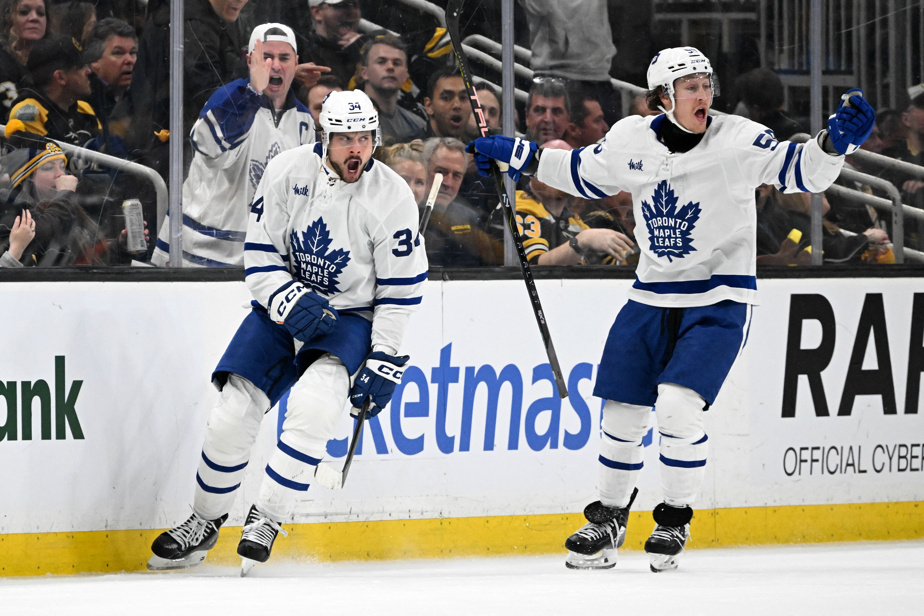
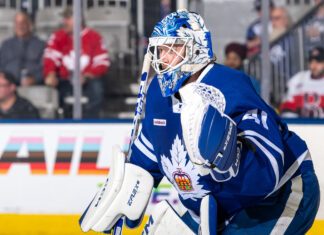







![Craig Berube Post Game, Blues 5 vs. Leafs 1: “We gave them three goals… The [3-1] goal was lazy hockey” Craig Berube, Toronto Maple Leafs head coach](https://mapleleafshotstove.com/wp-content/uploads/2024/10/berube-craig-lak-pg-100x70.jpg)
